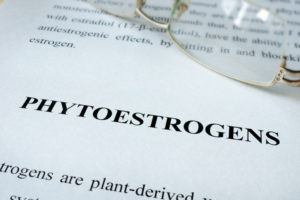 Consumers, patients and clinicians have long wrestled with the safety issues of phytoestrogens regarding the breast and uterine endometrium in particular. Phytoestrogens are used for both prevention and treatment strategies in areas of bone health, cardiovascular issues, bone density, hot flashes and more. Research has been debated regarding their effects on endometrial or breast tissues. The authors performed a systematic review (SR) and meta-analysis (MA) of existing published evidence.
Consumers, patients and clinicians have long wrestled with the safety issues of phytoestrogens regarding the breast and uterine endometrium in particular. Phytoestrogens are used for both prevention and treatment strategies in areas of bone health, cardiovascular issues, bone density, hot flashes and more. Research has been debated regarding their effects on endometrial or breast tissues. The authors performed a systematic review (SR) and meta-analysis (MA) of existing published evidence.
An extensive search of electronic databases and literature sources identified 1070 records; 543 publications were removed due to duplicate titles and abstracts. Other articles were removed from the review and analysis due to screening criteria which left 33 systematic reviews and meta-analysis publications. These 33 were randomized, placebo-controlled clinical trials (RCTs) in which peri- and/or postmenopausal women received phytoestrogens vs. placebo or phytoestrogens vs. hormone replacement therapy. These studies also included changes in endometrial thickness as measured by trans-vaginal ultrasound and/or breast density as measured by mammogram.
Within these 33 RCTs, there was a total of 4047 participants. Thirty reported on endometrial thickness and 4 on breast density and one study reported both. Of the endometrial thickness studies, 25 compared phytoestrogens with placebo; 2 with hormone replacement therapy (HRT) and 3 with both. In 3 studies, the phytoestrogen metabolite equol was the active intervention. In one, white kwao krua (Pueraria candollei var. mirifica,) was the phytoestrogen source; in 3, red clover (Trifolium pratense,). Two used lignans and 19 used isoflavones. In six of the latter, the soy isoflavones genistein and/or daidzein were used. All studies of breast density compared isoflavones to placebo. Doses ranged from 10 mg/d (equol) to 270 mg/d (lignans). Duration was from 8 to 156 weeks. Of the endometrial thickness studies, 5 included peri- and postmenopausal women; the rest, postmenopausal women only. All of the breast density studies were in postmenopausal women.
In the meta-analysis of endometrial thickness studies that used placebo (n = 31), the effect of phytoestrogens was nonexistent or negligible when comparing to placebo. In 1 of the studies, ET increased with phytoestrogens; in 3, it decreased; but in the others, there was no difference. When compared with HRT in five RCTs, phytoestrogens did not affect endometrial thickness. Body mass index (BMI) was a potential confounder of phytoestrogens’ effect on ET; age and study duration were not confounders. The lower the BMI, the greater the increase in ET in the phytoestrogen groups. In four RCTs from the meta-analysis, phytoestrogens did not affect breast density compared to placebo in postmenopausal women or perimenopausal women.
Commentary: The results of this systematic review and meta-analysis should be reassuring to all, about the safety of phytoestrogens on endometrial thickness and breast density in peri and postmenopausal women, at least in use for up to three years. There was a previous meta-analysis with different findings, but this is likely due to the inclusion of newer studies and correction of classification errors. There have been only a few RCTs that have assessed ET and BD with phytoestrogen supplementation, compared to many studies on their effectiveness and safety in treating menopause symptoms, especially hot flashes and night sweats. These studies vary greatly in the plants and formulations used, as well as the daily dose and duration of use. In addition, many had missing data. To further understand the safety and efficacy of phytoestrogens, there is a need for more RCTs and of longer duration.
Reference: Mareti E, Abatzi C, Vavilis D, Lambrinoudaki I, Goulis DG. Effect of oral phytoestrogens on endometrial thickness and breast density in perimenopausal and postmenopausal women: a systematic review and meta-analysis. Maturitas. June 2019;124:81-88.

